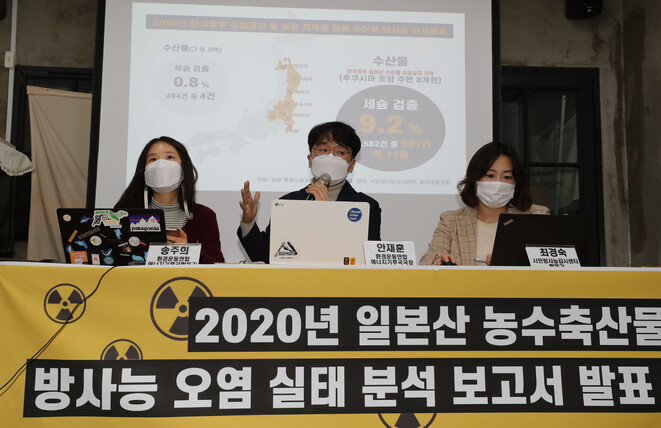Analysis of radioactive contamination of agricultural and marine products by environmental groups, Fukushima Prefecture, etc.
Cesium detected 11 times higher than in other regions in aquatic products. “Import ban should be maintained”

Officials from the Federation of Environmental Movements and the Civic Radiation Monitoring Center are presenting a report on the radioactive contamination of Japanese agricultural, livestock and livestock products in 2020 at the Environmental Movement Association in Jongno-gu, Seoul on the morning of the 17th. Senior Reporter Kang Chang-Kwang [email protected]
It was found that cesium, a radioactive substance, was detected in 9.2% of marine products in eight prefectures, including Fukushima Prefecture, Japan, where the Korean government bans imports. That’s 11 times higher than that of other regions in Japan. The environmental group stressed that the Korean government should not accept the Japanese government’s request to import seafood in the Fukushima area. On the 17th, the Federation of Environmental Movements and the Civic Radiation Monitoring Center held a press conference at Hwanamu Hall, the Association of Environmental Movements in Jongno-gu, Seoul, and released the ‘2020 Radioactive Pollution Condition Report of Japanese Agricultural and Livestock Products’. This is the data analyzed by the Ministry of Health, Labor and Welfare’s analysis of cesium (CS-134, CS-137) levels in 139731 cases of agricultural and livestock products across Japan last year. According to the report, the detection rate of cesium in Fukushima Prefecture and the surrounding eight prefectures was 11 times higher than in other regions. A survey of 10,582 seafood products in Fukushima, Ibaraki, Tochigi, Gunma, Miyagi, Iwate, and Aomori prefectures revealed cesium in 987 cases, 9.2% of the total. In other regions, cesium was detected in 4 cases, 0.8% of 494 cases. In particular, in 264 cases of gondul catfish in Gunma Prefecture, 65.3% of 404 cases, 140㏃/kg of cesium was detected, exceeding 100㏃ (becquerel)/kg, which is the distribution limit of the Japanese government. In Chiba prefecture, cesium was detected up to 83㏃/kg in 54 out of 200 (27%). Cesium was detected in 169 cases (44.1%) of 383 cases of wild fish in Fukushima Prefecture. The maximum was 76㏃/kg. In Chiba Prefecture, cesium was detected in 15 of 94 cases (16%), and the maximum value was 63㏃/kg. In the case of regions not subject to the aquatic import ban, 7.3㏃/kg of cesium was produced in 1 out of 2 crucian carp in Saitama, and 5.8㏃/kg of cesium was found in 1 out of 7 catfish. Agricultural and livestock products, wild animals, and processed foods in Fukushima Prefecture and surrounding areas also showed significantly higher cesium detection rates than in other areas. Cesium was detected in 18% of agricultural products in eight prefectures, including Fukushima Prefecture, and 12% in other areas. In Miyagi Prefecture’s Kotake mushroom, 1700㏃/kg of cesium was produced, which is 17 times the standard value. As for wild animals, cesium was detected in 51.2% in 8 prefectures, including Fukushima Prefecture, and 10.6% in other regions. It was found that 5,000㏃/kg, 50 times the standard value, was detected in wild boars in Fukushima Prefecture. In this regard, Ahn Jae-hoon, head of the Energy and Climate Bureau of the Federation for Environmental Movements, explained, “The high cesium level in wild boars, the top predators, is an indicator that the surrounding environment itself is contaminated with radioactivity.” Moreover, the number of cesium tests last year decreased to 37% compared to 2019, but the detection rates did not differ significantly. It is also possible to infer that cesium may be detected in more foods if the population is increased. Because of this, environmental groups claim that food safety in the Fukushima area has not been improved. Director Ahn explained, “The total number of inspections decreased significantly from 37,6696 in 2019 to 139731 last year, but the number of detections did not decrease significantly from 6946 to 5001.” did. Because of this, environmental groups criticized the Japanese government’s demand that South Korea should lift the ban on imports of agricultural and fishery products in Fukushima and emphasized that it should maintain the import ban. On the 11th, Japanese Foreign Minister Toshimitsu Motegi said in a speech on the 10th anniversary of the Great East Japan Earthquake, “It is very unfortunate to be in a country or region that regulates the import of Japanese food even after 10 years have passed since the earthquake.” Based on this, we will do our best to realize deregulation as soon as possible.” The Korean government imposed temporary special measures in March 2011 and September 2013, such as a ban on the import of seafood from the Fukushima area, and these measures are still in effect. By Kim Min-je, staff reporter
